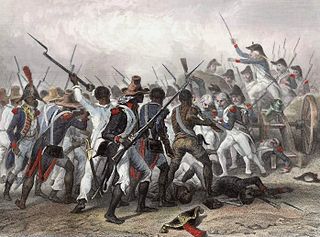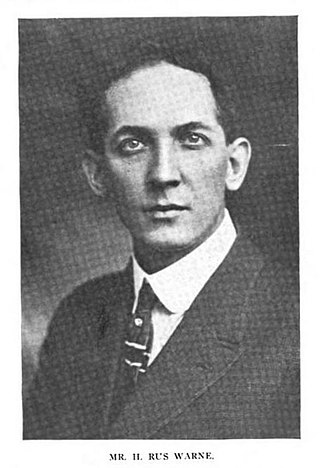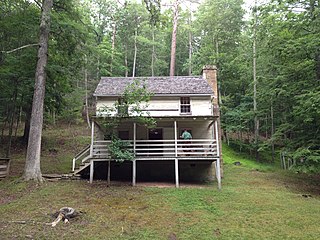
William Alexander MacCorkle, was a United States teacher, lawyer, prosecutor, the ninth Governor of West Virginia and state legislator of West Virginia, and financier.

George Boxley (1780–1865) was a white abolitionist and former slaveholder who allegedly tried to coordinate a local slave rebellion on March 6, 1815, while living in Spotsylvania, Virginia. His plan was based on "heaven-sent" orders to free the slaves. He tried to recruit slaves from Orange, Spotsylvania, and Louisa counties to meet at his home with horses, guns, swords and clubs. He planned to attack and take over Fredericksburg and Richmond, Virginia. Lucy, a local slave, informed her owner, and the plot was foiled. Six slaves involved were imprisoned or executed. With his wife's help, Boxley escaped from the Spotsylvania County Jail and, despite a reward, he was never caught.

Droop Mountain Battlefield State Park is a state park located on Droop Mountain in Pocahontas County, West Virginia. The park was the site of the Battle of Droop Mountain, the last major battle of the American Civil War in the state taking place on November 6, 1863. John D. Sutton, a West Virginia private in the Union Army at the battle, became the leader in the movement to create the park when he served in the West Virginia House of Delegates. Dedicated on July 4, 1928, Droop Mountain Battlefield became the first state park in West Virginia.

The Lincoln Log Cabin State Historic Site is an 86-acre (0.3 km²) history park located eight miles (13 km) south of Charleston, Illinois, U.S., near the town of Lerna. The centerpiece is a replica of the log cabin built and occupied by Thomas Lincoln, father of U.S. President Abraham Lincoln. Abraham Lincoln never lived here and only occasionally visited, but he provided financial help to the household and, after Thomas died in 1851, Abraham owned and maintained the farm for his stepmother, Sarah Bush Lincoln. The farmstead is operated by the Illinois Historic Preservation Agency.

Ripshin Farm, also known as the Sherwood Anderson Farm is a historic farm property at the junction of Routes 603 and 732 near Troutdale, Virginia. It was developed as a summer home and later year-round home by writer Sherwood Anderson (1876–1941), and is where he wrote most of his later works. It was declared a National Historic Landmark in 1971.

The Reynolds Homestead, also known as Rock Spring Plantation, is a slave plantation turned historical site on Homestead Lane in Critz, Virginia. First developed in 1814 by slaveowner Abram Reynolds, it was the primary home of R. J. Reynolds (1850-1918), founder of the R. J. Reynolds Tobacco Company, and the first major marketer of the cigarette. Upon liberation of the plantation in 1863, 88 people were freed from captivity and enslavement. It was later designated a National Historic Landmark in 1977. The homestead is currently an outreach facility of Virginia Tech, serving as a regional cultural center. The house is open for tours.

The 4 Lazy F Ranch, also known as the Sun Star Ranch, is a dude ranch and summer residence in Jackson Hole, Wyoming, built by the William Frew family of Pittsburgh in 1927. The existing property was built as a family retreat, not as a cattle ranch, in a rustic style of construction using logs and board-and-batten techniques. The historic district includes seven cabins, a lodge, barn corral and smaller buildings on the west bank of the Snake River north of Moose, Wyoming. The property was added to the National Register of Historic Places in 1990.

The Sweeney-Conner cabin is a structure within the Appomattox Court House National Historical Park. It was registered in the National Park Service's database of Official Structures on June 26, 1989.

Craik-Patton House is a historic home located at Charleston, West Virginia. It was built by James Craik and his wife, Juliet Shrewsbury, in 1834 in the Greek Revival style. It was originally located on Virginia Street in Charleston, but moved to its present site in 1973 to save it from the threat of demolition. It features four massive columns that support the extended center roof with pilasters placed above the front facade. It was faithfully restored and preserved for the public by the National Society of the Colonial Dames of America in the state of West Virginia and open for tours year round.

Sunrise, also known as MacCorkle Mansion, is a historic home located at Charleston, West Virginia. It was built in 1905 by West Virginia's ninth governor, William A. MacCorkle (1857-1930). It is a long, three-story stone mansion. Its gabled roof is dotted with dormers and chimneys and surmounts an intricate, but wide, cornice which gives the illusion that the house is smaller than it actually is. The Georgian structure rests on a bluff overlooking the Kanawha River, and from the northern portico one can see nearly the entire city of Charleston. The north side features four magnificent Doric, or neo-classic, columns which support the cornice and ashlar-finished pediment. In 1961 Sunrise Foundation, Inc., was formed for the purpose of purchasing the mansion and grounds.

Spring Hill Cemetery Historic District is a national historic district located at Charleston, West Virginia. The district is a 172-acre (70 ha) site located on a series of tree shaded and landscaped hills overlooking central Charleston and includes the following cemeteries: Spring Hill Cemetery, Mountain View Cemetery, B'nai Israel Cemetery, Lowenstein Cemetery, and Mount Olivet Cemetery. It is West Virginia's largest cemetery complex. The district features Spring Hill Mausoleum, a stone faced reinforced concrete structure constructed in 1910. Notable graves throughout the cemetery include the following:

The Col. James Graham House is a historic log cabin located on West Virginia Route 3 in Lowell, West Virginia. It was built in 1770 as a home for Col. James Graham, the first settler of Lowell, and his family. It was later the site of an Indian attack on the Graham family in 1777. The house was added to the National Register of Historic Places on March 16, 1976. The Graham House is the oldest multi-story log cabin in West Virginia. It is currently operating as a museum.

The Ball–Sellers House, also named the John Ball House, is the oldest building in Arlington County, Virginia. It is an historic home located at 5620 Third Street, South, in the county's Glencarlyn neighborhood. The Arlington Historical Society, which owns the building, estimates that the one room log cabin was built in the 1740s.

Wildwood, also known as the General Alfred Beckley Home, is a historic home located at Beckley, Raleigh County, West Virginia. The house is open as the Wildwood House Museum and was listed on the National Register of Historic Places in 1970.

Harry Rus Warne was a Charleston, West Virginia-based architect.
Henry Funkhouser Farm and Log House is a historic home located at Baker, Hardy County, West Virginia. Located on the property are the contributing log cabin; a log barn ; and a cellarhouse (1938). The log cabin was built about 1845, and is a two-story, side gable, single-pen house. A kitchen addition was built about 1900. Also on the property is the Funkhouser family cemetery. The property remains in the Funkhouser family.

"Lighthorse Harry" Lee Cabin, also known as Lee Cabin, is a historic home located in Lost River State Park, near Mathias, Hardy County, West Virginia. It was built about 1800, and is a two-story, frame and hewn-log structure. It was built by Henry "Light Horse Harry" Lee III (1756-1818) as a summer retreat from the heat of their eastern Virginia home. The property remained in the Lee family until 1879. The State of West Virginia acquired it in the 1930s as a portion of Lost River State Park and the state operates it as a museum.

The Beadles House is a historic house located at 515 Greene Acres Road near Stanardsville, Greene County, Virginia. It was built from 1788 to 1789 by Revolutionary War militia captain John Beadles. It is a two-story, chestnut and poplar log dwelling. It was listed on the National Register of Historic Places on November 22, 2000.

Ingles Bottom Archeological Sites is a set of archaeological sites, and national historic district located along the New River near Radford, Montgomery County, Virginia. The district encompasses a variety of archaeological sites relating to human occupation from 8000 B.C. to the present. It includes the site of a log cabin built about 1762, as the home of William Ingles (1729-1782) and his wife Mary Draper Ingles (1732-1815). The property also includes the site of a stable, family cemetery, and Ingles Ferry.

The Morgan Morgan Monument, also known as Morgan Park, is a 1.05-acre (0.4 ha) roadside park in the unincorporated town of Bunker Hill in Berkeley County, West Virginia. It is located along Winchester Avenue and Mill Creek. The park features a granite monument that was erected in 1924 to memorialize Morgan Morgan (1688–1766), an American pioneer of Welsh descent, who was among the earliest European persons to settle permanently within the present-day boundaries of West Virginia.






















